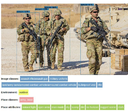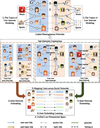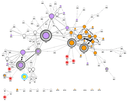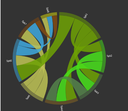Blogs
Read more about different aspects and implications of this project
Social Network Analysis for Criminology in ROXANNE
—
by Garg, Shivam
—
last modified
Nov 05, 2021 02:56 PM
Social network analysis provides an essential set of analytic tools to study people’s behavior: Social influence analysis, community detection, link prediction, and cross-network analysis are examples of such tools. Law enforcement agencies can benefit from them in criminology. In ROXANNE, we focus on several real crime cases and build a specialized tool for criminology that includes the state-of-the-art methods for each of these options.
ROXANNE Training Framework: Delivering the training material to end-users through remote (or physical) training sessions
—
by Garg, Shivam
—
last modified
Nov 05, 2021 02:57 PM
Learn facts about learning and our training methodology for effective use of the ROXANNE platform.
Ηow organized crime and cybercrime altered during the COVID-19 period
—
by Garg, Shivam
—
last modified
Nov 04, 2021 02:36 PM
The COVID-19 pandemic is expected to have a multifaceted impact on serious organized crime, particularly cybercrime. Lifestyle changes that arose in response to the restrictions during the epidemic, such as extended teleworking, widespread internet purchasing, and other behaviors, are unlikely to fade once the lockdown is lifted. As a result, cybercriminals will continue to seek ways to exploit these behaviors, either by modifying existing attacks or developing new ones.
Combining computer vision techniques with speech technologies for the fight against crime
—
by Garg, Shivam
—
last modified
Nov 05, 2021 02:58 PM
ROXANNE combines multiple analytics on various modalities (audio, text, image, metadata) to support LEAs in their investigations. In this post, we review how analysts and investigators can benefit from the significant progress achieved in computer vision in recent years, especially when combining it with speech or network analysis.
Dissemination & exploitation efforts in project ROXANNE
—
by Garg, Shivam
—
last modified
May 31, 2021 10:43 AM
ROXANNE project has completed about half of its journey until now. We are happy to share that with the support, feedback, and comments of our readers, stakeholders, end-users, and partners, we have achieved to create a preliminary version of this unique platform. We are certain that this platform will be used ethically for the betterment of society and we are ensuring checks for the same at various steps as well. In this blog, we will discuss some of the recent project updates and explore our efforts and objectives with respect to exploitation.
NLP technologies against online crime
—
by Garg, Shivam
—
last modified
Apr 27, 2021 09:41 AM
Big Data in Artificial Intelligence (AI) and Machine Learning (ML) technologies offer new opportunities. The principle is that an extensive amount of data is required for the best result of the scenario of fighting crime ML models. In the ROXANNE project, the technical development targets to significantly enhance the criminal network analysis based on text, speech, language, and video technologies.
ROXANNE Stakeholder Board
—
by Garg, Shivam
—
last modified
Apr 01, 2021 11:00 AM
As an EU-funded collaborative research and innovative project, ROXANNE has been accompanied since its launch by a Stakeholder Board (SB) for independent and methodological advice, counseling the consortium on the practical implementation of its goals, as well as on encountered issues regarding its progress, direction, and outcomes. This external project advisory group is formed of 16 interdisciplinary experts coming from diverse backgrounds, including law enforcement, academia, EU entities, international organisations, fellow research projects, and industry.
Multimodal networks integration improves the criminal entity network construction with the help of deep neural networks
—
by Garg, Shivam
—
last modified
Nov 05, 2021 02:58 PM
The network integration fuses information from ROXANNE platform component technologies for network analysis. In previous workloads, crime-related networks from different data sources are constructed. We propose a multilayer and cross-network structural analysis to provide methods for integrating information from several investigation cases and linking the data records across these.
Making Natural Language Processing work for Little Training Data
—
by Garg, Shivam
—
last modified
Nov 05, 2021 02:59 PM
In the ROXANNE project we are solving real-world problems which often do not have a large labelled training set. To overcome such data scarcity problems, we use the combination of distant supervision and noise-robust learning algorithms. Distant supervision serves as a way of obtaining a large amount of labelled data in an automatic manner. Such data is however often noisy so that feeding them directly to DNN models will hinder the learning process. Nonetheless, noise-robust learning algorithms will help the models to focus on the correct instances in the training set so that the models will not be affected much by the noise.
The Benefits of Using Automatic Speaker Recognition in LEAs’ Investigative Processes
—
by Garg, Shivam
—
last modified
Nov 05, 2021 03:00 PM
Traditional manually performed forensic analyses are language-dependent and time-consuming, while automatic speaker recognition systems are fast and language-independent (nevertheless, the role of a forensic expert is still irreplaceable for the presentation of the results). There is also other voice biometric information that can be automatically extracted from a person’s voice, such as the gender of a speaker. The bottom line is that current automatic speaker recognition systems, such as the one currently built by the ROXANNE consortium, can greatly improve the analytical work efficiency, enabling law enforcement agencies of any size to investigate faster.
Probabilistic modelling for speaker recognition in criminal networks
—
by Garg, Shivam
—
last modified
Nov 05, 2021 03:00 PM
Speaker recognition is a technology that uses computer algorithms to analyze speech patterns and determine the identity of the speaker in a recording. Speaker recognition is an integral part of the ROXANNE platform because the identities of speakers in recordings from criminal investigations are usually not known. However, the speaker recognition scenario in criminal investigations differs from the most other speaker recognition scenarios because in addition to the audio of the recordings, we also have access to information about how the recordings are related. In particular, information about who has talked to whom is important. This information forms a network structure between the recordings. Naturally, it is important for the investigation to accurately uncover the network structure. Interestingly, using prior knowledge about the expected network structure in criminal networks may also improve the accuracy of speaker recognition.
Technology to enhance forensic speaker analysis
—
by Garg, Shivam
—
last modified
Nov 05, 2021 03:01 PM
Law enforcement agencies investigate criminal networks to find participants, understand their role in the network and, eventually, collect evidence for prosecution. Opportunities to identify criminals often lie in the traces that their communication leaves behind. A cell phone leaves many different traces, but the availability and usability of these modalities may vary. Therefore, it is worthwhile to invest in multiple modalities, increasing the chance of a useful result.
Ethics Oversight in ROXANNE
—
by Garg, Shivam
—
last modified
Nov 05, 2021 03:01 PM
Ethics oversight in ROXANNE exists across four levels: the European Commission Ethics Checks; the External Ethics Board; the Internal Ethics Board; ethics-focussed work within the project. Overall, the ROXANNE project is in a positive position in terms of meeting the strict ethical requirements from the Commission. So far, the project is also fulfilling the recommendations generated within the project to ensure compliance with ethical, societal, and legal standards. The strict oversight that the ROXANNE project is subject to ensures that none of these standards are violated in the work of the project. The ROXANNE consortium is committed to ensuring that the ROXANNE project is carried out in a responsible way, and that the technologies developed are used in an ethical and lawful manner.
Link prediction algorithms to enhance criminal network analysis
—
by Garg, Shivam
—
last modified
Nov 05, 2021 03:02 PM
Roxanne project will include link prediction algorithms to enhance criminal network analysis by law enforcement agencies. A recent study shows that link prediction can predict links among criminals, although the effectiveness and accuracy of the prediction may be affected by the amount of unknown information and the specific type of relational data under analysis
Ethically developed technologies for safer societies – The ROXANNE project case study
—
by Garg, Shivam
—
last modified
Mar 01, 2022 11:12 AM
In order to implement an approach that incorporates ethical and legal concerns in ROXANNE, there are two research focuses that specifically deal with ethical and legal concerns which are led by Trilateral. The first area of focus ensures that the research carried out during the ROXANNE project abides by the standards of research ethics and that data protection legislation is applied to training algorithmic models used in the platform. A second research focus considers the issues which ROXANNE could raise in terms of ethics, societal values, fundamental rights, and applicable law if it is used in real investigations.
Overview of LTEC Voice Databases & ASR System Training
—
by Garg, Shivam
—
last modified
Nov 05, 2021 03:03 PM
The main problem in the application of ASR systems in forensics is the accuracy and reliability of the results of such system. The accuracy of identification methods depends on a number of factors that cannot always be assessed. Since it is very difficult to assess the impact of all the factors encountered in forensic speaker examinations, the performance of such systems can best be determined using voice databases developed on the basis of audio recordings submitted for examinations. Despite the variety of created voice databases that attempt to record voices under a variety of conditions, forensic investigations still encounter factors, whose impact on an automated speaker recognition system, is often unknown. ROXANNE BLOG briefly presents characteristics of voice databases - BALSAS_LTv1.1 and BALSAS-200LT of the Forensic Centre of Lithuania (LTEC), also describes ASR VOICE training performance using BALSAS_LTv1.1. In the ROXANNE project, LTEC will use the described voice databases (BALSAS_LT200 and BALSAS_LTv1.1) to assess the recognition accuracy of the existing ASR systems VOICE and BATVOX, as well as the ones developed internally.
Forensic Automatic Speaker Recognition (FASR) : Problems and prospects
—
by Garg, Shivam
—
last modified
Feb 05, 2021 04:02 PM
At present speaker identification by voice in forensics, criminalistics and other applications receive a great deal of attention and huge financial resources. In many cases, this is due to the increasing use of sound recording devices, and in particular, the widespread use of mobile technologies in criminal activities and their recordings, and accordingly, the use of various latest trending technologies in the fight against organised crime and international terrorism. In the ROXANNE project, speaker recognition is one of the main and most important elements of the system. However, direct application of automatic speaker recognition (ASR) systems in forensics raises a number of issues. In general, ASR methods work well only under controlled conditions, sufficiently good signal quality and relatively long duration. The main problem in the application of ASR systems in forensics is the accuracy and reliability of the results of such system. This blog briefly describes problems arising using this systems in forensic speaker identification, and prospects of effective using ASR system with traditional auditory-instrumental methods.
Automatic Speech Recognition: Setting, Benefits and Limitations
—
by Garg, Shivam
—
last modified
Nov 05, 2021 03:03 PM
Audio is an important modality for criminal investigations. This is true for different kinds of audio and in particular for spoken content. Be it a part of files, streams or posts which are accessible on the web and social media, a recording collected from mobile devices for investigations and interviews, or a conversation recorded via intercepted telephone calls - speech can be encountered in many environments. Audio data by itself, however, presents unstructured information. Without having access to the spoken content, no further analysis and processing is possible. Enter Automatic Speech Recognition (ASR).
Legally compliant state-of-the-art capabilities to fight and prevent transnational crimes
—
by Garg, Shivam
—
last modified
Nov 05, 2021 03:04 PM
With the increased reliance on new and rapidly evolving technologies to commit and facilitate crime, law enforcement agencies (LEA) must keep pace with the constant technological developments to stay ahead of criminals and maintain a safe environment. The ROXANNE advanced technical platform aims to enhance the quality of investigative work in tracking and identifying criminals by developing an innovative solution that combines speech, text and video data analysis with the analysis of organized crime networks. To be effective and lawfully implemented, such innovative police technologies must be part of an appropriate legal framework based on the principle of law, fundamental human rights and other applicable legislation ( Often innovative fields, such as data analysis for law enforcement purposes and the use of novel analytical methods, are subject to legal uncertainty due to outdated legal texts or insufficient guidance from legislators, be it domestic or regional)
Forensics Visualizations as a catalyst for fighting organized crime
—
by Garg, Shivam
—
last modified
Nov 05, 2021 03:04 PM
Criminals often employ sophisticated technologies in planning and executing their illegal activities, as well as concealing the revenues stemming from them. Suppressing organized crime remains an important but challenging task for Law Enforcement Agencies (LEAs) for several reasons. In this context, visualisation plays a key role in augmenting the human analysis and providing context to the analyst.
ROXANNE platform & network analysis
—
by Garg, Shivam
—
last modified
Nov 05, 2021 03:05 PM
Maximizing the speed of investigations is one of the key factors in the presence of dynamically changing and technologically savvy organized criminals. A number of automated network analysis methods were developed in the past that can be borrowed to help investigators to identify key players, paths and relations within the resulting networks in order to analyse the development of the network, find effective strategies toward its destabilisation or disruption and overall to increase investigation effectiveness.
Combination of Speech and Text Technologies with Criminal Network Analysis: Steps Toward First Field-Test Event of ROXANNE Project
—
by Garg, Shivam
—
last modified
Nov 05, 2021 03:06 PM
For law enforcement agencies (LEAs) to keep up in this new environment, they must change their approach to criminal investigations as relying mainly on physical evidence and witness statements is no longer sufficient in many cases. Training in research-based investigative procedures and access to related tools and resources can help law enforcement officers carry out successful investigations. It can help LEAs solve cases more swiftly and even prevent crimes in some cases.
Web based Training (WbT) for the engagement of technology providers and LEAs through EU Funded Projects
—
by Garg, Shivam
—
last modified
Apr 06, 2020 09:00 AM
A combination of “synchronous” and “asynchronous” modes can be adopted for WbT instructions. This blog discusses various possibilities around the same.
Artificial Intelligence Adoption in Law enforcement
—
by Garg, Shivam
—
last modified
Apr 28, 2021 09:10 AM
The ROXANNE project has a principal objective to enhance the LEAs’ efforts to discover criminal networks and identify their members. It has capitalised on certain aspects of AI technologies. Speech and language technologies (SLTs), visual analysis (VA) and network analysis (NA) will become the basis of ROXANNE platform, which will enhance criminal network analysis capabilities by providing a framework for extracting evidence and actionable intelligence.
A Generic and Flexible Platform for ROXANNE Systems Development
—
by Garg, Shivam
—
last modified
Jan 15, 2020 07:14 AM
Airbus has designed its Multi-source and Multi-media analysis solution through the Concept of Generic Architecture which enables the regrouping of multimedia processing software products and presenting them in different possible configurations, based on one common and generic architecture.
Dissemination & Exploitation Aspects of ROXANNE
—
by Garg, Shivam
—
last modified
Jan 06, 2020 12:32 PM
This blog discusses various aspects of communication, exploitation and dissemination related to this project.
Analysis of streaming data for security by ITML
—
by Garg, Shivam
—
last modified
Dec 19, 2019 10:56 AM
Project kick-off meeting
—
by admin
—
last modified
Nov 13, 2019 08:46 AM
The project kick-off meeting was held at Idiap Research Institute, in Martigny Switzerland, on 3-4 September 2019.
Document Actions


























